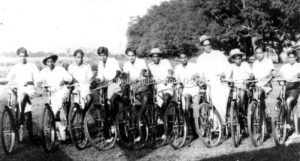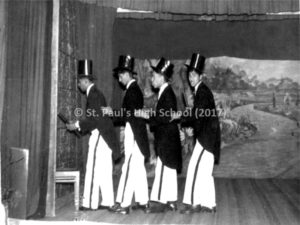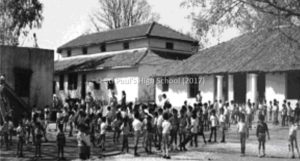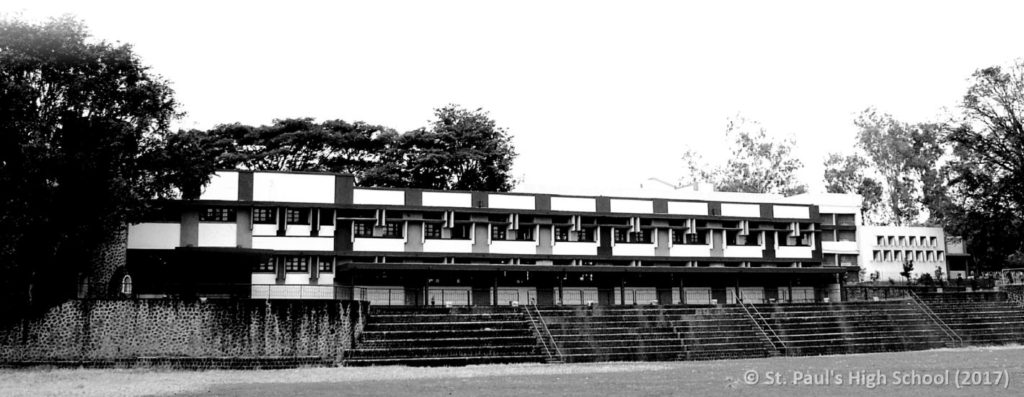
The predecessor to Gnanmata Bal Bhavan
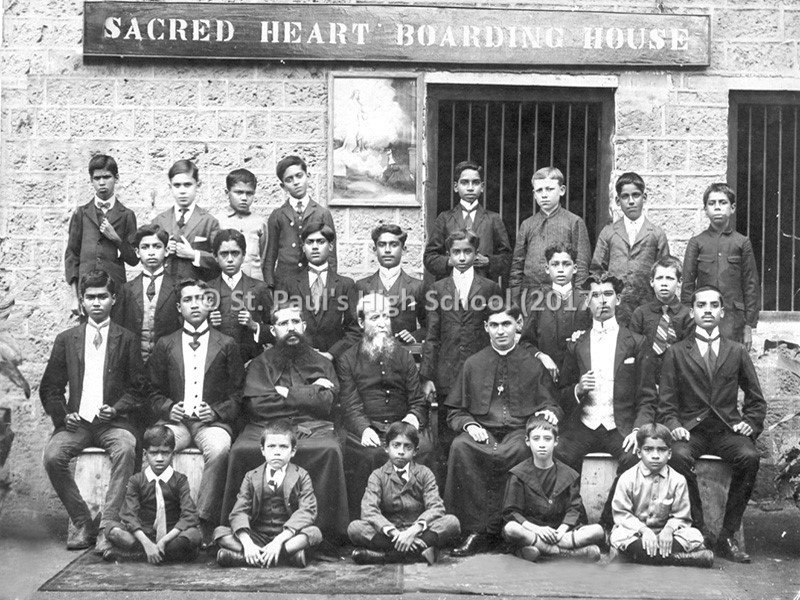
The boarding house has been the backbone of St. Paul’s for many years. Already in 1870 the expenses of the boarders was mentioned. In 1878 during the famine a number of starving children were brought in such an emaciated and perilous state that most died. An ex- student of 1901 writes that at his time there were boarders who lived away from the school compound and were paraded to and fro for classes. In 1908 twelve orphan boys were boarding in outhouses in St. Mary’s chapel compound. This orphanage was the original boarding. It was originally started in an outhouse of the main house where the priest of St. Mary’s chapel lived together with the other Jesuit staff members of the school. This outhouse was remodelled to accommodate these orphans.
In 1913 another boarding house was inaugurated with ten boarders. The parents of these boys paid for their upkeep. Their families were Goans who were living in other places because of their jobs. These boys formed part of ‘Sacred Heart Boarding House’. In 1917 there were twenty six boarders in Sacred Heart Boarding, who paid fees. Their ages ranged from 8 to 22 years. When the outhouses were all demolished to make place for other school buildings, the top floor of the 1921 building became the dormitory for forty six boarders. In the newly built 1924 building part of the chapel was partitioned off to become the study hall of the boarders.
When the Fathers bought the houses across the road, B.C. 68 in 1904 and B.C. 66 in 1923, they were dislocated from the chapel / school compound. All the Fathers moved to the bungalow in B.C. 66. Initially this became the ‘Fathers’ residence’. Later it would become the ‘middle dormitory’. When the plans for the new ‘Fathers’ residence’ in B.C. 68 were drawn in 1923, there were supposed to be two more buildings added to the present existing structure. On the right was supposed to be a wing for the new boarding and on the left was a whole wing for the orphanage. These parts of the plan were never completed. Only the central portion of the plan was completed. The Fathers stayed in the ‘middle dormitory’, (B.C. 66) till the new high ceiling, steep roofed Fathers’ house was built in 1934.
As the years went by the boarding grew from one to two and finally three buildings. There were the lower or big boys’ dormitory, the middle dormitory, which had now been vacated by the Fathers, and the top dormitory for the small boys (a number of rooms at the top of B.C. 66). This continued until 1957 when there were one hundred and twenty boarders. Obviously there was overcrowding. So from 1952 there was a lot of discussion on finding an alternative for the various buildings of the hostel.
The problem was partly solved in 1960 when the neighbour’s bungalow in B.C. 64 was bought. The bigger boys’ dormitory was shifted there. The middle dormitory stayed the same and the small boys were later moved to the top floor of the Fathers’ house, which was then vacant and had more space.
A few glimpses of the boarders of the 1900’s to 1950’s performing various activities in their leisure time. | Cycling Ahead | Cultural Show |
From among these boys of Sacred Heart Boarding House came some of the finest talents in St. Paul’s School. In the past at least ten ‘Boys of the Year’ were from the boarding house. Quite a few were at the top of the class if not first in class. Some of the best actors, singers, comedians and especially athletes and sportsmen came from among them. Two future Olympians were boarders and honed their skills in the daily games and school tournaments. They were a rowdy, noisy lot when all together, but they were hard working and serious when needed. There was camaraderie and a great loyalty among them even in their pranks. However there also was tremendous discipline, hard work and great dedication to any job given to them. They were available for all types of extra work and for any co-curricular activity. Their close bonding with the young Fathers in charge of them gave them a whole set of values and attitudes that made men out of boys, which most cherish long after they left school. In 1952 the name of the boarding house was changed from ‘Sacred Heart Boarding House’ to ‘Sacred Heart Hostel’. The numbers swelled even more, till there were more than one hundred and fifty boys. The spirit in the boarding also changed. A new solution to the problem was sought. Suggestions were made of building a second floor on the 1912 building, and even of buying another piece of land near Club road for the hostel and ferrying the boys to and fro for classes by bus. Boarders even tried to raise their own funds by concerts and entertainment programmes. This was considered too impractical for the amount needed. The stumbling block was always the money needed. So every plan was dropped. Finally, between 1966-67 after several plans and sketches, the new hostel was built in B.C. 64. All the old dormitories were discarded for the new long spacious building, which had separate study halls and dormitories for bigger and smaller boys and was self-contained. No more would boarders have to go up and down from dormitories to study hall and then to dining room, nor keep the bulk of their belongings in the ‘boxes room’.
In the early 1970s, Jesuits, world-wide, began to ask serious questions in all their institutions. One fact that became clear was that the Jesuits had in some institutions forgotten their original roots. We had forgotten what we had originally started out to do — work for the less privileged in society. In St. Paul’s School and Sacred Heart Hostel, the orphans had been forgotten, the locals had been forgotten, those from abroad were asking us to set policies favouring them, and finally even the poorer youth from the town and villages were set aside because of the greater demands from the rich and well-to-do. Worse still, it was no more possible to satisfy the sometimes limitless demands of these boys and some of their parents. The boys were just not happy to be in the hostel. The attitudes of these nouveau riche boys were totally different from those of boys from earlier years.
For example, the parents of boys from Africa asked that the school shift from the State Board (Matric / SSC) to the Cambridge Board. The reason given was that it would be better for their children to go abroad to England for further studies. Providentially the Fathers rejected the idea as this would affect the vast majority of the students in the school 99% of whom would not even go abroad for studies.
But in fairness it must also be pointed out that to some extent circumstances beyond the control of the Fathers also brought about many of the changes.
- The war ended and, soon after, so did the epidemics. Therefore the number of orphans dwindled considerably. This is the reason that there were no more orphans sent for admission. Children of those parents who had died during the war were repatriated to England. So their number dwindled drastically and vanished totally.
- The political changes in Africa saw more and more migration to Europe, Canada and Australia. So too, the Middle East was gaining freedom, and English education was now more easily available in Goa. So the Goan boys from Africa or those whose parents worked in the Middle East stopped coming. The boys from Goa entered our own boarding houses in our sister institutions at Margao and Mapuca, so they too stopped coming. This brought about the change in the clientele of St. Paul’s Hostel.
- Still further Kannada, became compulsory for education in Karnataka and the school readily fell in line with the three language formula. After Independance. And the liberation of Goa, Goan boys preferred studying in their own mother tongue of Konkanni in English medium schools of Goa. So they became a small insignificant number in the whole school. All these factors brought about the change in the hostel.
Winds of Change
The Sacred Heart Hostel needed a rethinking based on changing times. While it had been catering to the rich for a long time, the need was gradually felt for having a boarding for the less privileged, and thus Sacred Heart Boarding House transitioned to Gnanmata Bal Bhavan, in around 1976.

